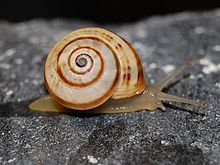Theba pisana
| Theba pisana | |
|---|---|
 |
|
| A live and active individual of Theba pisana | |
| Scientific classification | |
| Kingdom: | Animalia |
| Phylum: | Mollusca |
| Class: | Gastropoda |
| (unranked): |
clade Heterobranchia clade Euthyneura |
| Superfamily: | Helicoidea |
| Family: | Helicidae |
| Subfamily: | Helicinae |
| Tribe: | Thebini |
| Genus: | Theba |
| Species: | T. pisana |
| Binomial name | |
|
Theba pisana (Müller, 1774) |
|
| Synonyms | |
|
|
clade Euthyneura
clade Panpulmonata
clade Eupulmonata
clade Stylommatophora
informal group Sigmurethra
Theba pisana, common names the white garden snail, sand hill snail, white Italian snail, Mediterranean coastal snail, and simply just the Mediterranean snail, is an edible species of medium-sized, air-breathing land snail, a terrestrial pulmonate gastropod mollusk in the family Helicidae, the typical snails.
This species is native to the Mediterranean region, however, it has become an invasive species in many other countries worldwide. Theba pisana is a well-known agricultural pest in numerous parts of the world. The shell color varies from white to yellow-brown with light brown spiral markings.
The species is native to the Mediterranean region. The type locality is Italy.
The distribution of Theba pisana includes the Mediterranean region and adjacent Atlantic coasts from central Morocco to north western Europe:
The species has been introduced to numerous other areas, including:
In many of these places T. pisana has become a problematic invasive species and a serious agricultural pest.
This species is already established in the USA, and is considered to represent a potentially serious threat as a pest, an invasive species which could negatively affect agriculture, natural ecosystems, human health or commerce. Therefore it has been suggested that this species be given top national quarantine significance in the USA.
...
Wikipedia
